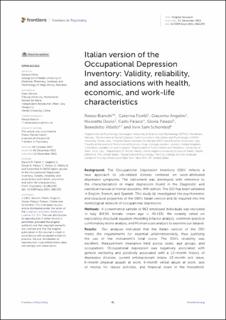| dc.description.abstract | Background: The Occupational Depression Inventory (ODI) reflects a new approach to job-related distress centered on work-attributed depressive symptoms. The instrument was developed with reference to the characterization of major depression found in the Diagnostic and statistical manual of mental disorders, fifth edition. The ODI has been validated in English, French, and Spanish. This study (a) investigated the psychometric and structural properties of the ODI's Italian version and (b) inquired into the nomological network of occupational depression.
Methods: A convenience sample of 963 employed individuals was recruited in Italy (69.9% female; mean age = 40.433). We notably relied on exploratory structural equation modeling bifactor analysis, common-practice confirmatory factor analysis, and Mokken scale analysis to examine our dataset.
Results: Our analyses indicated that the Italian version of the ODI meets the requirements for essential unidimensionality, thus justifying the use of the instrument's total score. The ODI's reliability was excellent. Measurement invariance held across sexes, age groups, and occupations. Occupational depression was negatively associated with general wellbeing and positively associated with a 12-month history of depressive disorder, current antidepressant intake, 12-month sick leave, 6-month physical assault at work, 6-month verbal abuse at work, lack of money for leisure activities, and financial strain in the household.
Conclusions: The ODI's Italian version exhibits robust psychometric and structural properties, suggesting that the instrument can be fruitfully used for addressing job-related distress in Italian-speaking populations. Furthermore, the present study relates occupational depression to important health, economic, and work-life characteristics, including past depressive episodes, antidepressant medication, sickness-related absenteeism, workplace violence, and economic stress. | en_US |

